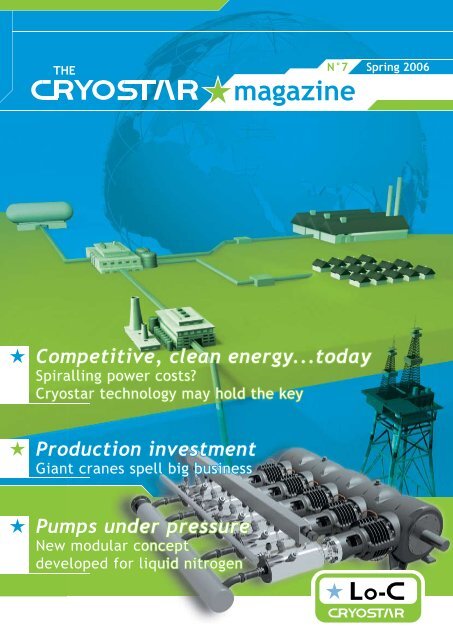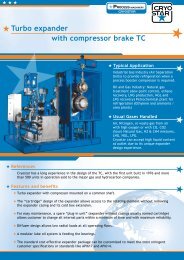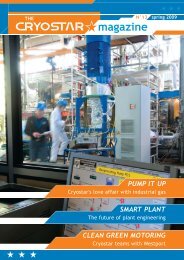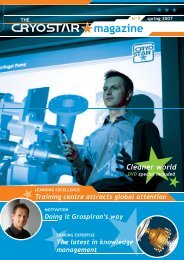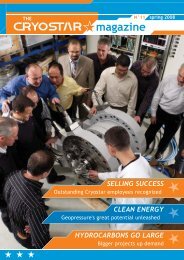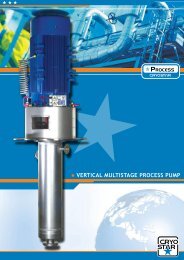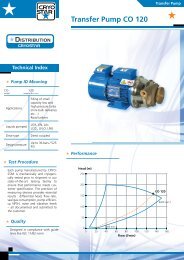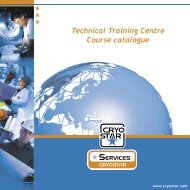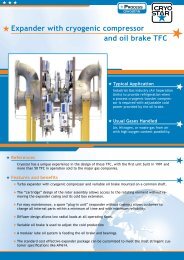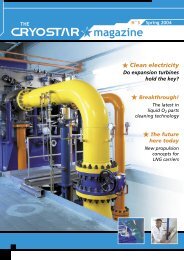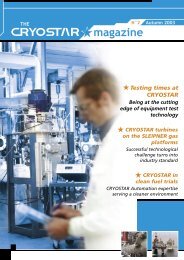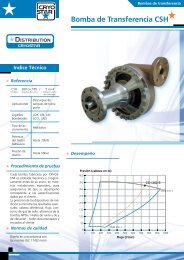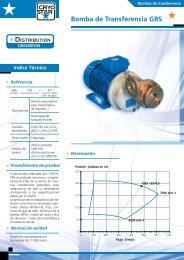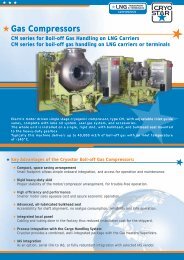The Cryostar Magazine N°7 : pdf file
The Cryostar Magazine N°7 : pdf file
The Cryostar Magazine N°7 : pdf file
You also want an ePaper? Increase the reach of your titles
YUMPU automatically turns print PDFs into web optimized ePapers that Google loves.
N°7<br />
Spring 2006<br />
Competitive, clean energy...today<br />
Spiralling power costs?<br />
<strong>Cryostar</strong> technology may hold the key<br />
Production investment<br />
Giant cranes spell big business<br />
Pumps under pressure<br />
New modular concept<br />
developed for liquid nitrogen
EDITO<br />
Clean energy, lower power costs and greater plant efficiency, return on investment in two to<br />
three years... the answers we all want to hear in the face of today’s spiralling cost of oil and<br />
natural gas.<br />
<strong>The</strong> outlook for affordable energy from traditional sources is not bright. Already many<br />
industries in the developed world are feeling the pain of too-high factory gate prices, in<br />
shrinking markets, against stiff competition from low cost, low taxation emerging<br />
economies.<br />
In many countries the ordinary citizen is also being hit by fast rising electricity bills, power<br />
cuts and rising knock-on retail prices. It is an issue that affects all of us today and one which<br />
has worrying implications for the future.<br />
No, CRYOSTAR is not waving the proverbial ‘<strong>The</strong> End is Nigh’ placard. But we are in the<br />
business of raising awareness about technology that can help our customers.<br />
Let’s take clean energy - CRYOSTAR has the turbine technology to generate low to carbonfree<br />
electricity. Lower power costs and greater efficiency? Our turbines can help cut costs or<br />
increase output - it’s up to you, the customer.<br />
And we have more answers to the problems of power generation. For many years, our<br />
engineers have been studying the issue in relation to our business, our technology and how<br />
CRYOSTAR can provide solutions.<br />
Since 1986, our expertise has provided customers with more than 1,000GWh of recovered<br />
electricity. And we can do more. Be it exploiting kinetic energy, geothermal or geo-pressure.<br />
It could be installing technology that exploits waste heat at an existing plant – typically<br />
producing one to 12MW of clean electricity.<br />
So, if power, the production of power and cost containment is of interest, then I urge you to<br />
read our feature Competitive, clean energy...today on page 3. CRYOSTAR has the technology<br />
to provide solutions to issues confronting your business right now.<br />
Daniel MEYER<br />
President<br />
Competitive, clean energy...today ............. p 3<br />
Giant cranes spell big business ............. p 6<br />
Customer survey results ............. p 7<br />
High pressure flows for new pump ............. p 8<br />
News ............. p 9<br />
eBusiness, the one-stop-shop ............. p 10<br />
Events ............. p 11<br />
Tools and datas ............. p 11<br />
<br />
Spring 2006
Competitive, clean energy...today<br />
<strong>The</strong> price of oil, natural gas and electricity is spiraling and this means companies face<br />
crippling running cost rises – many have been driven out of business. <strong>Cryostar</strong> technology<br />
holds the key to exploiting competitive, clean energy, today...<br />
As energy prices continue to rise rapidly, so does the need to optimize energy usage and recovery. This trend is<br />
being accelerated by government pressure on industry to reduce carbon emissions to the bare minimum.<br />
Since 1986, <strong>Cryostar</strong>’s energy recovery expertise has provided customers with more than 1,000GWh of<br />
recovered electricity.<br />
<strong>The</strong> principle of energy recovery is turning untapped energy into electricity. <strong>The</strong> expansion of a working fluid,<br />
such as gas, transfers kinetic energy into mechanical energy. <strong>Cryostar</strong> turbo-expanders generate electricity by<br />
utilising the expansion process to rotate a wheel and generate electricity.<br />
<strong>Cryostar</strong> has also been perfecting the radial in-flow turbine to harvest wasted energy from a working fluid<br />
into electricity. This is achieved by the direct conversion (primary cycle) of kinetic or mechanical energy into<br />
electricity, utilising <strong>Cryostar</strong> Geo-pressure units, the same principle by which wind power operates. Geo-pressure<br />
units work in parallel with pressure reduction valves on gas networks.<br />
<strong>The</strong> second method (binary cycle) is by converting low grade heat (100°C) into a working fluid, then<br />
expanding it through the radial in-flow turbine which converts the kinetic energy into electricity, the principle<br />
used for geothermal and waste heat electricity plants.<br />
<strong>Cryostar</strong>’s radial inflow turbine is particularly suitable for harvesting geo-pressure as it is up to 92 per cent<br />
efficient.<br />
In the geo-pressure energy recovery unit in Arlesheim (GVM), commissioned by <strong>Cryostar</strong> in 2003, a pressure<br />
drop is needed to reduce the natural gas pipeline pressure of 55 bar to meet the low pressure of the local gas<br />
distribution networks.<br />
In other words, the gas flow from 35,000 Nm3/h is allowed to expand and during this process drives the<br />
<strong>Cryostar</strong> turbine within the geo-pressure energy recovery unit.<br />
<strong>The</strong> turbine wheel drives a gearbox coupled to a synchronous generator. <strong>The</strong> resulting 1.9MW of electricity<br />
recovered in this way is then supplied to local electricity suppliers. <strong>The</strong> electrical efficiency of the whole installation<br />
is about 85 per cent*, vastly superior value when compared to CHPs, to gas and steam turbine and even fuel cells.<br />
Mr Kreyenbühl, of GVM, said: “With all the thought and effort that has gone into the conception of this first<br />
unique power station in Switzerland, we believe that all <strong>Cryostar</strong>’s objectives for reliability and service have<br />
been met. Especially to reach a 10 per cent higher power efficiency than guaranteed in the contract.”<br />
Spring 2006
CLEAN ENERGY<br />
As a travelling companion of natural gas, geo-pressure<br />
energy follows electrical base load demand, meaning<br />
the supply of electricity generated from geo-pressure<br />
is as secure as the gas supply itself.<br />
Natural gas comes out of the ground at very high<br />
pressure, called geo-pressure. It is this pressure that<br />
moves the gas through the distribution pipelines.<br />
However, the pressure is too high to be used safely<br />
by end-users of gas (power stations, industrial, commercial<br />
and domestic users).<br />
<strong>The</strong> pressure at the production platform is between<br />
100-800 bar. In order for the gas to be suitable for<br />
domestic use it has to be available at 1 bar, the pressure<br />
of the gas used by a cooker for example.<br />
At several points in the system, therefore, gas goes<br />
through ‘stations’, where the pressure of the gas is<br />
reduced by squeezing it through a valve. Reducing<br />
the pressure in this way releases energy. In most<br />
instances today, this energy is not used though it is<br />
possible to generate carbon-free electricity, merely<br />
by installing <strong>Cryostar</strong> turbine generation systems.<br />
<strong>The</strong> gas passes through the turbine as the geo-pressure<br />
is reduced, and the turbine generates electricity. No<br />
gas is burned or used up in this process. And as it is<br />
not the gas but the actual pressure reduction which<br />
produces energy, installation of an expander turbine<br />
driving a generator in parallel of throttle valve in natural<br />
gas pressure reducing stations is a way to produce almost<br />
CO2-free electricity.<br />
Temperature drop through the expander is around<br />
1.5-2°C per bar. It means that the gas must be<br />
preheated before the expander to avoid negative<br />
temperatures after expansion which may lead to<br />
problems due to hydrocarbons condensation, hydrate<br />
formation and pipe material damages.<br />
If preheating is by using waste heat from gas-driven<br />
engines, which also produce electricity, the CO2<br />
emissions are at a remarkably low level of 200-250g<br />
CO2/kW.h elec. for the gas engine, the turbine itself<br />
consumes no gas nor emits CO2. If waste heat is<br />
recovered from an existing industrial process or even<br />
solid oxide fuel cell, it can drop to zero CO2 emissions.<br />
Geo-pressure also applies to other applications where<br />
pressure is reduced such as for example with steam.<br />
Imagine the huge energy potential which stays<br />
unexploited under our feet: only 0.1% of our globe<br />
is colder than 100°C. One km³ of 200°C hot granite<br />
cooled by 20°C delivers about 10 MW of electric<br />
power for a period of 20 years. One km 3 of 180°C<br />
hot geothermal water-cooled to 100°C delivers about<br />
7 MW of electric power for a period of 250 years.<br />
Put another way: installed 1 MW is enough to supply<br />
2,500 homes every year.<br />
Geothermal water has been used since the Roman<br />
times, principally for bathing, but today it is also a<br />
way to produce electricity, even for a low temperature<br />
source of about 100°C.<br />
Hot water from an aquifer source is pumped to<br />
the surface. This natural source of heat is used to<br />
vaporise an appropriate working fluid mixture with<br />
a boiling point below 100°C. <strong>The</strong> vapour is then<br />
expanded through a radial inflow turbine which<br />
drives a generator and delivers electricity to the grid.<br />
<strong>The</strong> low pressure vapour is then condensed with an<br />
existing cold source (fresh water or ambient air) and<br />
the liquid is pumped back to the evaporator to begin<br />
the cycle again.<br />
<strong>The</strong> hot geothermal water, which was cooled by the<br />
cycle, can be used for district heating and then<br />
re-injected at depth.<br />
<strong>The</strong> <strong>Cryostar</strong> technology of high efficient radial<br />
inflow turbine perfectly matches the needs of this<br />
application. Unlike axial turbines, the efficiency of<br />
<strong>Cryostar</strong>’s expander can reach 92 per cent.<br />
<br />
Spring 2006
CLEAN ENERGY<br />
Thanks to in-house developed tools, <strong>Cryostar</strong> engineers<br />
have the ability to optimise the process and the<br />
expander design to offer to the customer the best<br />
compromise between recovered power and cost.<br />
<strong>Cryostar</strong> is currently working with a German<br />
customer in order to provide a tailored turbine<br />
solution for a geothermal application. <strong>The</strong> objective<br />
is to produce electricity from geothermal heat, with<br />
100 l/s of geothermal fluid at 180°C.<br />
Operating a closed loop binary cycle, the appropriate fluid<br />
mixture is expanded inside the <strong>Cryostar</strong> turbine to<br />
produce six to 7MW of clean electricity without any<br />
CO2 emission. <strong>The</strong> remaining low grade temperature<br />
is able to supply a local district heating network.<br />
Waste heat recovery<br />
A waste heat binary plant is quite similar to a<br />
geothermal binary plant, hence the thermal energy<br />
is coming from an unexploited heat source (100°C-<br />
200°C typically), for example a thermal oil loop in<br />
an industrial plant, steel factory, cement factory,<br />
glass manufacturer etc. Thanks to a closed loop<br />
binary cycle, the selected fluid mixture is expanded<br />
inside the <strong>Cryostar</strong> turbine to produce one to 12MW<br />
of clean electricity<br />
Potential sources include: biomass boilers; biogas<br />
engines; residual heat from industries; solar heat;<br />
and fuel exhaust heat.<br />
<strong>Cryostar</strong> has been a world leader in radial inflow<br />
turbine technology for more than 30 years and its<br />
superior product quality is recognised across the<br />
globe.<br />
<strong>The</strong> company continuously builds on its world-class<br />
engineering skills and innovative drive, to keep at<br />
the forefront of technological development in the<br />
industry.<br />
<strong>Cryostar</strong> Lo-C Energy has<br />
been established as a result<br />
of the rapidly increasing<br />
need for low carbon energy<br />
recovery and covers a variety of applications such<br />
as pressure let down, geothermal plants, waste heat<br />
and natural gas liquefaction.<br />
<strong>The</strong> newly established Lo-C business unit within<br />
<strong>Cryostar</strong> focuses solely on low carbon technologies<br />
for energy recovery, emphasising the company’s<br />
long-term strategic commitment to customers in this<br />
area.<br />
* “Stromerzeugung mit Erdgas-Enstpannungsanlage”<br />
issued from German Magazin GWA 6/2004<br />
CO 2 emissions from different energy sources<br />
1.2<br />
1<br />
kg CO2/kWh elec<br />
0.8<br />
0.6<br />
0.4<br />
0.2<br />
0<br />
Solar Photovoltatic<br />
Geo-Pressure with fuell cell<br />
Geo-Pressure with CHP<br />
NG Turbine<br />
NG Steam Turbine<br />
Oil<br />
Wood *<br />
Coal<br />
Biomass *<br />
* Without bonus for CO2 reduction by photosynthesis<br />
Spring 2006
INVESTMENT<br />
Giant cranes spell big business<br />
Strong growth in all business segments ensures continued expansion for <strong>Cryostar</strong>. This<br />
increase in activity hasn’t happened overnight. <strong>Cryostar</strong>’s turnover has risen from €33<br />
million in 2000 to more than €100 million in 2005.<br />
In February, the first phase of a major extension<br />
programme was completed at <strong>Cryostar</strong>’s manufacturing<br />
facility in France. It’s a €2.5 million project that<br />
is adding 25 per cent in production capacity. <strong>The</strong><br />
extension project, initially projected to begin in the<br />
2006 financial year, was moved ahead given the<br />
increase in activity already experienced in 2005 and<br />
the projected trend into 2006.<br />
It is the booming LNG shipping sector that is a key<br />
contributory factor in the need for extending facilities.<br />
Changes in ship-board technology are also playing<br />
into <strong>Cryostar</strong>’s hands as some of the LNG ships<br />
are now being built with natural gas reliquefaction<br />
units on board. By equipping the Hesingue site now<br />
with all the necessary technology and capability to<br />
manufacture these units, <strong>Cryostar</strong> will be in a strong<br />
position to respond to market needs.<br />
<strong>The</strong> new workshop which is extending production<br />
space by 1,200sqm constitutes the first phase of the<br />
extension project. It will be totally dedicated to LNG<br />
machines and LNG reliquefaction units.<br />
<strong>The</strong> installation of two 50-tonne cranes gives the<br />
ability to lift machines up to 100 tonnes.<br />
<strong>The</strong> second phase of the project is due to begin and<br />
be completed in 2006 and comprises a 500sqm test<br />
facility which will mainly be testing large machines,<br />
such as turbines, compressors and the future LNG<br />
on-board reliquefaction units.<br />
Until the current site expansion, however, <strong>Cryostar</strong>’s<br />
growth has been largely one of personnel. Employee<br />
numbers are expected to increase from the current<br />
figure of just over 300 to between 320 and 330 in<br />
2006. <strong>Cryostar</strong> needs mechanical or process engineers<br />
and sales people with a technical or mechanical<br />
background. Good project managers who can be<br />
the link between customers and <strong>Cryostar</strong> staff are<br />
also vital.<br />
<strong>The</strong> company’s strength lies not just in its technology,<br />
but in the people who are out there designing, manufacturing,<br />
selling and maintaining it and building<br />
strong relationships with customers.<br />
It is, of course, not just on the LNG side of its business<br />
that <strong>Cryostar</strong> has seen considerable expansion. Sales<br />
of pumps and turbines for industrial applications<br />
have doubled in the last three to four years and one<br />
of the biggest regions for growth has been China.<br />
Also the machinery being manufactured is getting<br />
bigger and heavier. <strong>The</strong> turbines for hydrocarbon<br />
applications which used to be three or 4MW are now<br />
ranging from six-8MW and even more. That means<br />
the need for bigger and stronger lifting equipment.<br />
<br />
Spring 2006
CUSTOMERS<br />
Customer survey results<br />
<strong>Cryostar</strong>’s Customer Service Department recently conducted an e-survey<br />
of 500 customers to determine how the company can better meet their<br />
needs. As a result, <strong>Cryostar</strong> is to boost its efforts in the areas of customer<br />
relationship management, with the possible launch of new CRM tools and<br />
portals, spares deliveries and the opening of its training centre.<br />
Didier Walch, Customer Service Director, said: “We have analysed the<br />
results of this survey very carefully and will in the coming months work on<br />
the highlighted improvement areas.<br />
“A return rate of 13 per cent was achieved, quite high compared to the<br />
usual 10 per cent return for electronic surveys. This shows our customers<br />
have a real interest in helping us to serve them better. We will of course<br />
keep customers informed on our progress.”<br />
In which domain do you feel the <strong>Cryostar</strong> Customer<br />
Department can/is help(ing) your business the most?<br />
Reducing unplanned downtime<br />
Reducing maintenance costs<br />
Maintenance outsourcing partner<br />
Other<br />
6%<br />
3%<br />
6%<br />
25% 19%<br />
22%<br />
Improving overall efficiency<br />
Spares management<br />
None<br />
19%<br />
Are you satisfied with the offer of Services provided<br />
by the <strong>Cryostar</strong> Customer Department?<br />
How would you rate the level of services offered by<br />
the <strong>Cryostar</strong> Customer Department?<br />
How would you rate the competency level within the<br />
<strong>Cryostar</strong> group and amongst their employees?<br />
15%<br />
3%<br />
21%<br />
3%<br />
27%<br />
55%<br />
27%<br />
61%<br />
17%<br />
73%<br />
First class Good Average Bad<br />
First class Good Average Bad<br />
Good<br />
Average<br />
How would you rate the speed of the <strong>Cryostar</strong><br />
Customer Department response time?<br />
How would you rate the quality of the <strong>Cryostar</strong><br />
Customer Department response?<br />
Are you satisfied with <strong>Cryostar</strong> Customer Department<br />
availability?<br />
4%<br />
2%<br />
24%<br />
23%<br />
38%<br />
47%<br />
3%<br />
49%<br />
26%<br />
28%<br />
56%<br />
First class Good Average Bad<br />
First class Good Average Bad<br />
First class Good Bad No<br />
Would you find any of the following services helpful in<br />
future?<br />
Are you satisfied that the <strong>Cryostar</strong> Customer Department<br />
is committed to finding you the correct solution?<br />
How would you rate the spare parts deliveries?<br />
37%<br />
43%<br />
2%<br />
27%<br />
36%<br />
2%<br />
34%<br />
55%<br />
4%<br />
60%<br />
Ordering spare parts on-line<br />
Certified service agents in your area<br />
Customer product online discussion forum<br />
Other<br />
Good<br />
Average<br />
No<br />
Always on time<br />
Average and sometime late<br />
Always late<br />
Spring 2006
PROCESS CONTROL<br />
High pressure flows for new pump<br />
<strong>Cryostar</strong> engineers have developed a new reciprocating<br />
pump specifically for liquid nitrogen at very high<br />
pressures and high flows. <strong>The</strong> HPP75/110 rates up<br />
to 690barg and up to 1100l/min respectively.<br />
<strong>The</strong> new modular concept pump is available with<br />
one cylinder (simplex version), three cylinders<br />
(triplex execution) or five cylinders (quintuplex<br />
execution), which allows a large range of flow at<br />
high pressures (See attached table).<br />
Samuel Zouaghi, <strong>Cryostar</strong>’s Director Distribution<br />
Line, said: “<strong>Cryostar</strong> has served the industrial gas<br />
market with cryogenic equipment for more than 30<br />
years and the launch of the HPP emphasises the<br />
company’s technological edge and continued devotion<br />
to meet customer needs.<br />
“<strong>The</strong> applications of the HPP and the nature of<br />
the cryogenic liquids which can be used are varied.<br />
<strong>The</strong> pump can be utilised as process or back up<br />
pump where high pressures and high flows are<br />
required, for example, pipe line supplying, but there<br />
are also many applications in oil and natural gas<br />
well service, like trailer mounted nitrogen units.”<br />
Cutting-edge technology<br />
Explaining the technology behind the new offer,<br />
Pierre Papirer, Pumps Design Manager, said: “<strong>The</strong><br />
HPP pump been developed in order to ensure its<br />
use for transfer applications as well as for process<br />
applications. <strong>The</strong> lubrication of the crank drive is<br />
made by oil splashing and the bearings assembled<br />
on eccentric shaft are rotating in a closed oil<br />
volume.<br />
“Two special roller bearings absorb the high axial<br />
loads due to the pressure acting on the piston<br />
(about 30tonnes) with low friction coefficient.<br />
<strong>The</strong> new cross-head guiding design, which is also<br />
lubricated by injected oil produces also very low<br />
friction.”<br />
the drive and is activated by the connecting rod<br />
displacement, eliminating any need for external oil<br />
pump and oil tank, said Pierre Papirer.<br />
He added: “<strong>The</strong> power needed by the drive can be<br />
supplied by an electrical motor through a pulley<br />
and belts system or by a thermal motor through an<br />
adequate gear for speed reduction.<br />
“<strong>The</strong> sealing of the drive is obtained by two adequate<br />
seals incorporated in a cartridge, which can be<br />
dismantled without opening the crank drive. <strong>The</strong><br />
frame material of the crank is a strong aluminium<br />
alloy in order to reduce its weight, which is especially<br />
interesting in case of trailer installation.”<br />
Pierre Papirer points out that the coupling between<br />
the cold end and the drive is easy to adjust to get<br />
the adequate clearance between the piston and the<br />
suction valve. It also integrates a plate in order to<br />
vaporise the process liquid in case of leakage.<br />
“<strong>The</strong> design of the cold end is an extrapolation of<br />
the MRP concept developed three years ago, which<br />
now has more than 100 machines in operation. <strong>The</strong><br />
large suction chamber integrating an appropriate<br />
filter and the suction valve design are made in such<br />
a way to reduce the pressure drops at the inlet,”<br />
said Pierre Papirer.<br />
“Additionally, the large vacuum<br />
volume around the cylinder permits<br />
to reduce the cold transfer,<br />
the heat intakes and as consequence<br />
allows getting a shorter<br />
cool down time and minimised<br />
liquid losses.”<br />
<strong>The</strong> low heat generated by the friction<br />
is dissipated by adequate thins<br />
in order to reach an acceptable<br />
balance temperature in continuous<br />
duty. <strong>The</strong> oil lubrication<br />
system is an integrated part of<br />
<br />
Spring 2006
PROCESS CONTROL<br />
<strong>The</strong> six high-pressure segments have a special design in order to get a high volumetric efficiency. As a<br />
consequence of reduced pressure drops, minor heat entrances, large vacuum volume and high volumetric<br />
efficiency, the required NPSH will be low and less than 1.5m at maximum running speed.<br />
<strong>The</strong> new low pressure seals, which are developed from a proven design, combined with the relative low<br />
maximum pump speed (500rpm), mean a longer life-span. <strong>The</strong> new cylinder design, adapted in line with<br />
international standards to take the high pressures, enables compensate contractions on welds during cool<br />
down periods where the internal envelop is cold and the external one still warm.<br />
Pierre Papirer added: “<strong>The</strong>re are two discharge pipe connections for each cylinder in order to reduce the<br />
pressure losses between the real pressure needed by the customer and the existing one at the discharge valve<br />
level.<br />
<strong>The</strong> pump is equipped in standard with a temperature probe in the intermediate piece between the cold end<br />
and the drive in order to detect any liquid leakage and an another one in the anti-pulsation block (when<br />
supplied) for cool down and cavitation controls.<br />
HPP 75/110 HPP3-75/110 HPP5-75/110<br />
Number of piston 1 3 5<br />
Piston diameter(mm) 75 75 75<br />
Stroke (mm) 110 110 110<br />
Speed range (rpm) 80--500 80--500 80--500<br />
Max flow l/min--GPM 210 / 55 660 / 175 1100 / 290<br />
Max delivery Pressure barg /Psig 690 / 10000 690 / 10000 690 / 10000<br />
Maw power (kW/HP) 400 / 500 900 / 1200 1500 / 2000<br />
<strong>The</strong> machine can also be<br />
equipped with a probe in the<br />
degassing line to check the<br />
correct liquid arrival and a<br />
probe at the cross-head level<br />
to detect any abnormal increase<br />
of temperature in the<br />
drive. A nitrogen purge inside<br />
the crank drive and inside the<br />
intermediate piece can be<br />
provided on demand.”<br />
News<br />
<strong>Cryostar</strong>’s China guarantee<br />
<strong>Cryostar</strong> has set up a new workshop in China to provide a better service to customers.<br />
With more than 260 square meters, state-of-the-art tools and a team of technical<br />
experts, <strong>Cryostar</strong> China has put in place a strong repair service for cryogenic equipment<br />
such as pumps, turbines and related items. This includes <strong>Cryostar</strong>’s high quality<br />
repair, labor and work, all of which will be guaranteed.<br />
<strong>Cryostar</strong> China has also installed a full set of special machines for the mechanical<br />
seal repair. This will enable customers to send damaged mechanical seals directly to<br />
<strong>Cryostar</strong> China for repair and thereby reduce the downtime of pumps. <strong>The</strong> mechanical<br />
seal is one of the most important parts of the pump.<br />
<strong>Cryostar</strong> Service Department’s objective is to enable customers to get a repair service<br />
on this essential part at a reduced cost in comparison to purchasing a new seal.<br />
For repair on mechanical seals, contact: Michael-Yaogu Liu, Service Supervisor, by<br />
tel: 86-571-85368331 or 86-13819170318, or fax: 86-571-85368409<br />
Brazil<br />
In March, <strong>Cryostar</strong> has opened its first office<br />
in South America. <strong>The</strong> South American<br />
region has continued to show significant<br />
growth rates and this initiative is an important<br />
element in <strong>Cryostar</strong>’s global growth<br />
strategy.<br />
<strong>The</strong> new office in Sao Paulo, Brazil will consist<br />
of both a sales office and a local workshop.<br />
<strong>Cryostar</strong> is the first of the major cryogenic<br />
pump and turbine manufacturers to<br />
open an office in this region, which means<br />
that in terms of responsiveness, local expertise<br />
and spare parts availability we will be<br />
able to offer our customers a unique and<br />
high level service.<br />
Spring 2006
FOCUS ON ... THE CRYOSTAR eBUSINESS<br />
eBusiness, the one-stop-shop<br />
<strong>Cryostar</strong> has launched an eBusiness portal to enable<br />
customers to order spare parts, check prices and track<br />
deliveries online.<br />
It is easy to use and includes the ability to view previous<br />
orders while offering delivery options tailored to the<br />
customer’s specific requirements.<br />
Via the portal on www.cryostarparts.com, all orders are<br />
confirmed within 48 hours, complete with an acknowledgement<br />
of prices, delivery date, shipping options and payment<br />
terms.<br />
<strong>The</strong> eBusiness one-stop-shop is available to customers<br />
through a log-in password supplied by <strong>Cryostar</strong>. Once<br />
log-in has been completed, the customer can order spare<br />
parts on-line, select special product options and fill all<br />
required fields to complete the order.<br />
To date more than 1,200 customers have been informed of<br />
the new service, which went live at the start of 2006.<br />
Neil Chraibi, <strong>Cryostar</strong>’s eBusiness coordinator, said: “This<br />
new online tool enables <strong>Cryostar</strong> to offer more solutions<br />
to customers and is in line with our determination to offer<br />
nothing less than a top-of-the-range service. Demand for<br />
such service is growing constantly and gaining more<br />
importance in the decision-making process when customers<br />
must select suppliers.<br />
“For many years <strong>Cryostar</strong> has considered superior service<br />
as a paramount objective of the company. We hope that<br />
eBusiness fulfils this and will help us to continue to consolidate<br />
partnerships with our customers.”<br />
Customers wishing to exploit the new service<br />
should contact the Customer Service Department<br />
on +3389702727 or email parts@cryostar.com<br />
10<br />
Spring 2006
EVENTS & TOOLS<br />
Events<br />
April 26-28, 2006<br />
EXPO-GAS 2006, Kielce Fairground, Zakladowa<br />
1, 25-672 Kielce, Pologne.<br />
May 30 – June 1, 2006<br />
POWERGEN EUROPE 2006, Cologne, Germany<br />
June 6-9, 2006<br />
WORLD GAS CONFERENCE 2006, Amsterdam,<br />
Nederland<br />
June 13-16, 2006<br />
16th World Hydrogen Energy Conference, Lyon,<br />
France<br />
July 17-21, 2006<br />
Cryoprague 2006, Prague, Czech Republic<br />
August 24-26, 2006<br />
FIGAS 2006, Lima, Peru<br />
September 19-22, 2006<br />
SVARKA - WELDING 2006, GASSUF 2006,<br />
Sokolniki Culture & Exhibition Centre, 1<br />
Sokolnicheskiy Val, Pav.4, Moscow 107113,<br />
Russia<br />
October 17-18, 2006<br />
EAGC 2006, Noga Hilton, 50, boulevard de la<br />
Croisette, 06414 Cannes Cedex, France<br />
Tools and datas:<br />
Head to PSI conversion<br />
Head in Feet<br />
1400<br />
1300<br />
1200<br />
1100<br />
1000<br />
900<br />
800<br />
700<br />
600<br />
500<br />
For Actuel Head in<br />
Hydrogen Multiply<br />
by 10<br />
Liquid Nitrogen SP. G. .804 Factor 2.86<br />
Liquid Hydrogen SP. G. .0695 Factor 32.5<br />
Water SP. G. 1.0 Factor 2.31<br />
Liquid Oxygen SP. G. 1.14 Factor 2.03<br />
Liquid Argon SP. G. 1.34 Factor 1.64<br />
400<br />
300<br />
PSI =<br />
Ft x SPG<br />
2.31<br />
200<br />
100<br />
FT =<br />
PSI x Water (2.31)<br />
Specific Gravity<br />
0<br />
0 100 200 300 400 500 600<br />
Pounds Per Square Inch<br />
Spring 2006 11
© CRYOSTAR - all rights reserved<br />
Contact: magazine@cryostar.com<br />
CRYOSTAR Brazil<br />
brazil@cryostar.com<br />
www.cryostar.com


